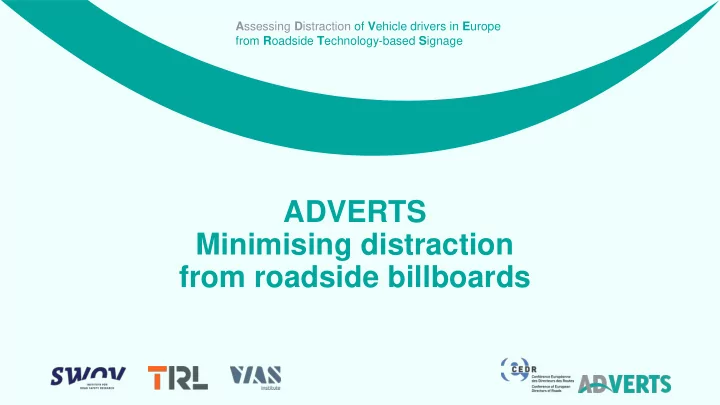

A ssessing D istraction of V ehicle drivers in E urope from R oadside T echnology-based S ignage ADVERTS Minimising distraction from roadside billboards
ADVERTS: setting the scene Ingrid van Schagen, SWOV Institute for Road Safety Research 11/10/2018 | Workshop
Why ADVERTS? • Distraction is a major challenge for road safety: • just a short moment of inattention can have serious consequences • Many sources of distraction: • activities: eating, drinking, passengers, calling, texting • surroundings: a traffic jam, a nice scenery, billboards 11/10/2018 | Workshop
Roadside billboards • Roadside billboards: • More and more prevalent (?) • More and more high tech and salient (?) • Meant to capture attention of passers-by • Hence, a potential threat to road safety 11/10/2018 | Workshop
ADVERTS’ objective • Compile recommendations for minimising distraction from roadside advertising • Looking at location, physical features, and content • Based on scientific knowledge and evidence • Aligned to current practices 11/10/2018 | Workshop
ADVERTS’ approach • Review of scientific knowledge • Inventory of current practices • Draft recommendations • Input from users • Final recommendations 11/10/2018 | Workshop
What do we know from research? Willem Vlakveld, SWOV Institute for Road Safety Research 11/10/2018 | Workshop
Literature search • Only scientifically sound studies • Around 50 studies were reviewed • Searched in: SCOPUS database of Elsevier, Google Scholar and the institutes libraries. 11/10/2018 | Workshop
Types of billboards • Traditional Billboards • Static Digital Billboards • Video Billboards 11/10/2018 | Workshop
Effect on crashes • 5 studies found on crash rates in the vicinity of billboards • Only 2 of the studies had a rather strong design • Results inconclusive 11/10/2018 | Workshop
Effect on gaze behaviour 1 • Drivers look at just around half of the billboards. • Glance durations of 2 seconds rarely occur (around 2% of the glances at billboards), but are very dangerous. • Drivers look longer and more often at static digital billboards than at traditional billboards. They look the most often and the longest at video billboards. 11/10/2018 | Workshop
Effect on gaze behaviour 2 • Driver look the most at billboards close to the forward field of view, but when they look, they look longer at billboards further away from the forward field of view. • Drivers look the most often and the longest at moments that advertisements change (static digital billboards). • Drivers look somewhat longer at affect-laden pictures. 11/10/2018 | Workshop
Effect on driving behaviour 1 • (Almost) no effect on speed. • Somewhat impoverished lateral control. • Drivers miss traffic signs more often in the vicinity of billboards. 11/10/2018 | Workshop
Effect on driving behaviour 2 • Reaction times are longer when a lead vehicle suddenly brakes in the vicinity of static digital billboards. • Drivers tend to take slightly more risky actions directly after having passed an affect-laden advertisement (both negative and positive). • Situation awareness does not seem to be affected by traditional billboards. 11/10/2018 | Workshop
Effect on driving behaviour 3 • Advertisements with large pictures and many text blocks could affect the driving task the most (only one study). • Drivers may react later on bright and large digital billboards (only one study). 11/10/2018 | Workshop
Not found in the literature • No studies found about the effects of billboards that look like road signs. • No studies found about the effect of messages that encourage drivers to take risky actions, such as dial now and win…. • No studies were found about difficulties drivers can encounter when brightly illuminated billboards hampers the detection of road signs. 11/10/2018 | Workshop
Remark Impossible to define distinct thresholds based on the literature (e.g. advertisements should be exposed for at least xx seconds on a static digital billboard). 11/10/2018 | Workshop
Current regulatory practices across Europe Stijn Daniels, Sofie Boets, Felix Vandemeulebroek Vias institute 11/10/2018 | workshop
Objective • Collect information on existing guidelines, regulations, practices and trends on RsA in CEDR-countries 11/10/2018 | workshop
Approach • E-mail survey sent to 26 CEDR member countries • Initial response from 18 countries • After processing sent again for verifying stated information • Additional oral interviews PEB-countries (6) (BE-FL, IE, NL, SI, SE, UK) • On-line information from AU and NZ • Overview grid with information about 20 countries • Placement criteria (longitudinal/lateral distance, vertical placement, viewing angle…) • Design criteria (flashing lights, exposure time, transition time, quantity of information,…) • Interview advertising industry 11/10/2018 | workshop
General findings • Level of detail varies greatly • Restrictions on placement in all countries (e.g. minimum longitudinal/lateral distance…) • Restrictions on design in about half of the countries • Restrictions on sequences (5 countries) • 2/3 of countries consider luminance (possible glare) • Usually complemented with guidelines 11/10/2018 | workshop
Permission procedure • Procedure usually regulated • Permissions not totally under control of road authorities • Criteria can be included in legislation or just in guidelines (or both) • Conflict of interest possible • Criteria not always transparent • Appeal procedures not always in place 11/10/2018 | workshop
Rules or guidelines? • Most countries have specific guidelines linked to RsA or (dangerous) objects along the roads. • Guidelines deal with assessment criteria • Almost always complementary to legislation • Advantages of guidelines as compared to legislation • Possibility to be more detailed and nuanced than legislation • Easier to adapt and to keep up to date • Transparent document • Advantages of legislation as compared to guidelines • Solid framework • Uniform interpretation of similar situations 11/10/2018 | workshop
Trends • Digital Out Of Home (DOOH) • Possible consequences of DOOH on RsA billboards: • Multiplication of 2m² digital billboards. • Increase of roadside digital billboards • Number of traditional roadside billboards might decrease • Potential contribution to development of smart cities. • One-to-one communication 11/10/2018 | workshop
11/10/2018
Thank you for your attention For more information, full reports, contact details, etc., see https://www.cedr-adverts.eu 11/10/2018 | Workshop
Recommend
More recommend